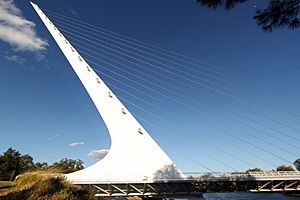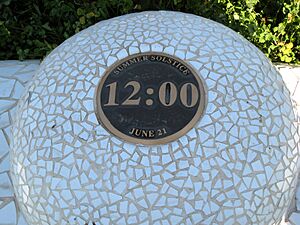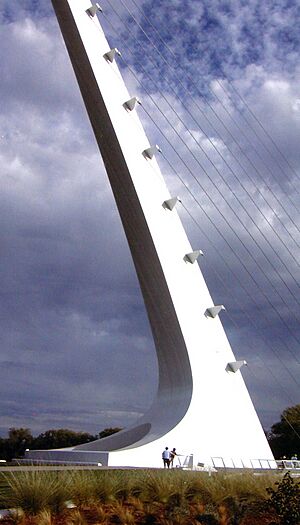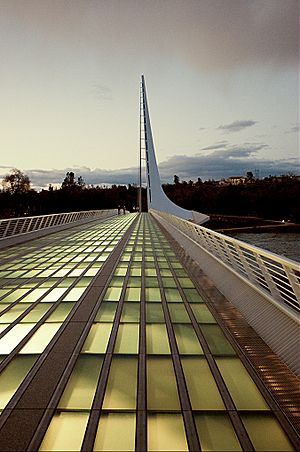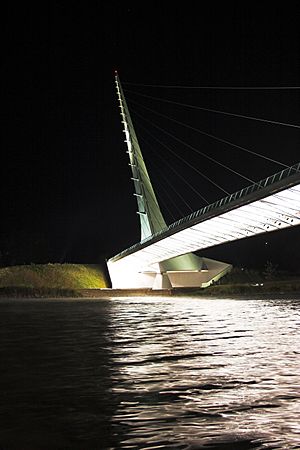Sundial Bridge at Turtle Bay facts for kids
Quick facts for kids Sundial Bridge |
|
|---|---|
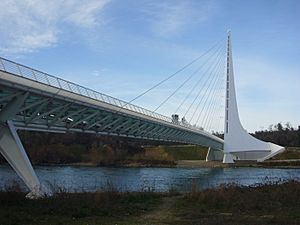 |
|
| Coordinates | 40°35′32″N 122°22′39″W / 40.59222°N 122.37750°W |
| Carries | Bicycles and pedestrians |
| Crosses | Sacramento River |
| Locale | Redding, California |
| Official name | Sundial Bridge |
| Characteristics | |
| Design | Cantilever spar cable-stayed bridge |
| Total length | 700 feet (210 m) |
| Width | 23 feet (7.0 m) |
| Clearance below | 26 feet (7.9 m) |
| History | |
| Designer | Santiago Calatrava |
| Opened | July 4, 2004 |
The Sundial Bridge is a special bridge in Redding, California. It crosses the Sacramento River and is only for people walking or riding bikes. This bridge is also a giant sundial, which tells time using shadows!
A famous architect named Santiago Calatrava designed it. The bridge was finished in 2004 and cost about $23.5 million. It has become a very well-known symbol of Redding.
Contents
Where is the Sundial Bridge located?
The Sundial Bridge helps people get to different parts of Turtle Bay Exploration Park. This park has museums about nature, art, and history. It also has beautiful gardens.
The bridge is also the start of the Sacramento River Trail. This trail is about 35-mile-long (56 km) and follows both sides of the river. It connects the bridge all the way to the Shasta Dam. You might even see fishermen in boats under the bridge, trying to catch salmon or trout!
How does the Sundial Bridge work as a sundial?
The tall tower of the bridge acts like the pointer of a sundial. This tower is 217-foot (66 m) tall and points north at an angle. It casts a shadow onto a large dial on the ground.
The bridge is sometimes called the world's largest sundial. However, its shadow is only perfectly accurate on one day each year. This is the summer solstice, around June 20 or 21. The time it shows is Pacific Daylight Time.
It's amazing to watch the shadow move! The tip of the shadow travels about one foot every minute. This means you can actually see the Earth spinning with your own eyes!
What is the design of the Sundial Bridge?
The Sundial Bridge is a special type of bridge called a cantilever spar cable-stayed bridge. It's similar to another bridge designed by Santiago Calatrava in Spain.
This bridge design uses a single tower that leans at a 42-degree angle. Strong cables connect only one side of the bridge deck to this tower. This makes the bridge look very dramatic and unique.
The bridge is 700 feet (210 m) long. It was designed so that it does not touch the water below. This helps protect the important salmon spawning grounds in the river.
What materials were used to build the bridge?
The cables for the bridge are very long, totaling 4,342 feet (1,323 m). They were made in England. The sundial's ground dial and a small area under the tower are decorated with white tiles from Spain.
The bridge deck itself is made of special see-through glass from Quebec. At night, lights underneath make the glass glow a beautiful blue-green color. The strong steel parts of the bridge were made in Washington state. They were brought to Redding in large 40-foot (12 m) sections by truck.
How much did the Sundial Bridge cost?
Plans for the bridge started in the 1990s. The city of Redding first planned to spend $3 million. But after Calatrava's design was chosen, the cost went up a lot.
Some people in Redding thought the bridge would be too expensive. Others, like doctors and lawyers, supported it. The bridge was finished in 2004, a few years later than planned. It ended up costing $23.5 million. Most of the money came from a group called the McConnell Foundation.
The high cost was seen as worth it because the bridge would bring more visitors to Redding. It has been very successful in doing this!
How has the Sundial Bridge helped tourism?
After the Sundial Bridge opened, the nearby Turtle Bay Exploration Park saw a big increase in visitors. In fact, visits went up by 42 percent in the first year!
By 2011, the city manager of Redding said that the bridge "continues to generate millions of dollars worth of commerce and tourism each year." This means the bridge helps local businesses and brings a lot of money into the area.
Sundial Bridge in the media
The Sundial Bridge has even appeared on the cover of a physics textbook! It was used to show how bridges can resist forces like wind and gravity.
Pink Sundial Bridge
Every year, a group called Nor-Cal Think Pink lights up the Sundial Bridge in pink. This happens on their "Think Pink Day." It's a special event to help people remember how important it is to find breast cancer early.
Images for kids
See also
 In Spanish: Puente del Reloj de Sol para niños
In Spanish: Puente del Reloj de Sol para niños


